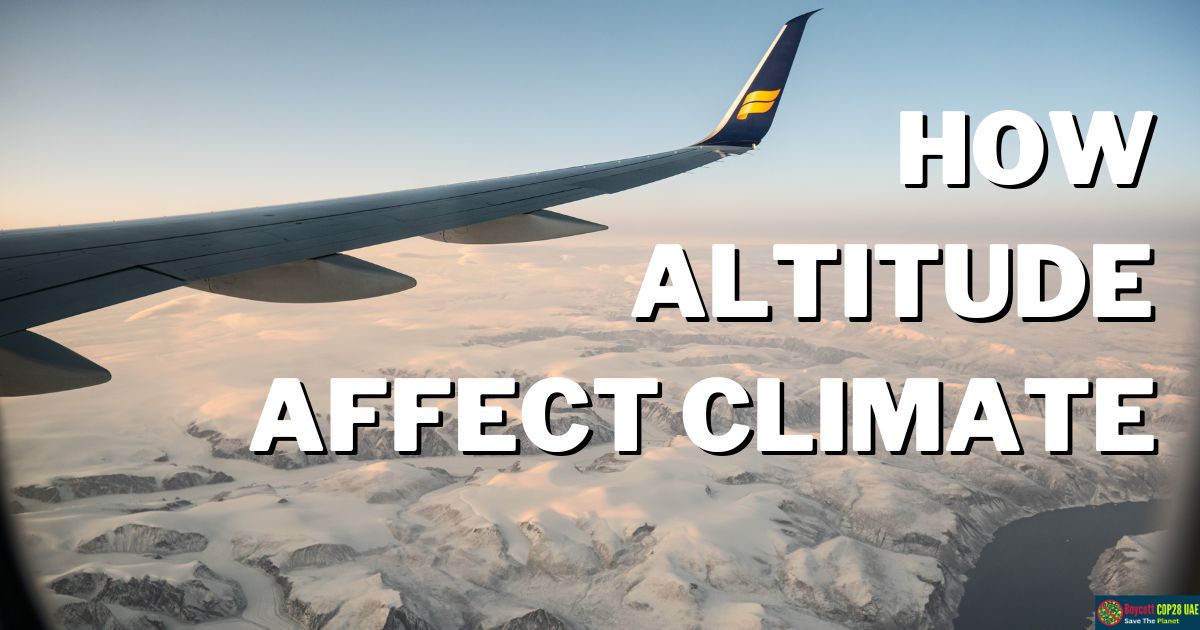However, climate is the average weather pattern in a particular region over a more extended period, usually 30 years or more. The altitude of a location can play a significant role in determining the climate of that region.
As you move higher in the atmosphere, the air pressure decreases, and the temperature drops, leading to various changes in the weather elements that define a location’s climate. Understanding these changes can help us predict and prepare for the unique challenges of high-altitude environments.
This article will explore the answer to your query: how does altitude affect climate and the resulting impact on living beings and the environment.
How Does Altitude Affect Climate?
To understand the climate conditions at different elevations, we must first explore how altitude increases affect various weather variables.
It’s important to note the difference between altitude and elevation. In meteorology and aviation, altitude usually refers to the height of an object or location above sea level. In contrast, elevation refers to the height of an object relative to the physical terrain, or ground level, beneath it.
In aviation, altitude has various meanings depending on the context. Indicated altitude is the altitude displayed on the altimeter, while absolute altitude is the distance between the aircraft and the ground below it.
On the other hand, true altitude is the aircraft’s height above sea level. Lastly, height refers to the vertical distance between the aircraft and a specific point below it. Although pressure and density altitude are also used, they may need to be clarified and relevant to the context of this article’s use of altitude.
For this post, altitude will always refer to an object’s height above sea level. With this in mind, we can now explore how climate conditions differ at varying altitudes.
Altitude Vs. Temperature
The sun sends out heat, including infrared radiation, which makes the Earth and its air hotter. This heat warms the land, the oceans, and the air around us.
Because heat rises, the air close to the ground is generally warmer than at higher altitudes. As you go higher, the temperature usually decreases by about 1 degree Celsius per 100 meters. Put another way; the temperature drops by roughly 5.4 degrees Fahrenheit for every 1,000 feet or 9.8 degrees Celsius for every 1,000 meters you climb. However, these numbers can vary depending on the local conditions.
Altitude Vs. Air Pressure
Air in the atmosphere isn’t empty; it has weight and is made up of gasses like nitrogen, oxygen, argon, and carbon dioxide. Dust and pollen are also found in the air. This helps us understand why air pressure changes with altitude.
When you’re on the ground, you feel the weight of the air pushing down on you because of gravity. As you go higher, there’s less air above you, so the pressure decreases. Also, the higher you go, the weaker the gravity, so air particles can spread out, lowering the pressure even more.
At very high altitudes, there’s hardly any air pressure. There’s insufficient oxygen to sustain life, but planes can fly quicker because of less air resistance and no turbulent weather.
Altitude Vs. Precipitation
The temperature and air pressure decrease as we go upward in the atmosphere. This causes places at higher altitudes to get more rainfall than places at lower altitudes. However, there must be enough moisture in the air to rain or snow.
The precipitation type depends on how cold it is when the moisture condenses. If it’s above freezing, it usually rains. If it’s below freezing, it usually snows.
Physical barriers like mountains can sometimes cause air to rise, leading to precipitation. This is called the mountain effect. Moisture-filled air is forced to rise up against the mountain, causing it to cool and condense into rain or snow on the windward side. The air is warm and dry on the other side of the mountain, so there’s less precipitation.
The Bottom Line: How Does Altitude Affect Climate
Altitude can significantly impact climate, as changes in altitude can lead to changes in temperature, precipitation, and other weather patterns. As altitude increases, the air pressure and density decrease, causing temperatures to drop. This means high-altitude areas like mountaintops tend to be colder than low-lying areas.
Additionally, altitude can affect precipitation patterns, with higher altitudes often experiencing more precipitation than lower altitudes due to air cooling as it rises and the subsequent condensation of water vapor. This can increase cloud cover and frequent precipitation, particularly in mountainous regions.
Altitude can also impact the amount of sunlight that reaches the Earth’s surface, with high-altitude areas experiencing more intense sunlight due to the thinner atmosphere. This can lead to increased solar radiation and higher temperatures during the day.
Overall, altitude plays a significant role in shaping the climate of different regions, with higher altitudes generally associated with colder temperatures, increased precipitation, and more intense sunlight.






